Force Between Magnetic Poles
The force of attraction or repulsion between two isolated magnetic poles of pole strength m₁ and m₂ separated by a distance d is:
F = (μ₀μᵣ/4π) × (m₁m₂/d²)
Where:
- μᵣ is the relative magnetic permeability of the medium
- For diamagnetic substance μᵣ < 1
- For paramagnetic substance μᵣ > 1
- For ferromagnetic substance μᵣ >> 1
- μ₀/4π = 10⁻⁷ where μ₀ is the absolute permeability of free space
Magnetic Moment
Magnetic moment, M is a vector quantity whose magnitude is M = m × ℓ where m is the pole strength and ℓ is the distance between the poles. Its direction is from south to north inside the magnet.
When Magnet is Split or Cut:
Split into n parts along length: Pole strength becomes m/n and magnetic moment becomes M/n
Cut into n parts perpendicular to length: Pole strength remains constant but magnetic moment becomes M/n due to reduction in length
Resultant Magnetic Moment
When two bar magnets are arranged at an angle θ between the like poles, the resultant magnetic moment is:
M = √(M₁² + M₂² + 2M₁M₂cosθ)
Bent Magnet Cases
- Bent into arc of circle: M' = (2M sin(θ/2))/θ where θ is in radian
- Bent at midpoint: M = M sin(θ/2)
Force Between Short Magnets
F = (μ₀/4π) × (M₁M₂/d⁴)
Diagram: Bar Magnet showing N-S poles and magnetic field lines
[Magnetic field lines emerge from North pole and enter South pole]
MAGNETIC LINES OF FORCE
The tangent drawn to the line of force at any point gives the direction of the magnetic field. An isolated North pole moves along a magnetic line of force.D
The number of lines of magnetic field passing through unit area normal to it is called magnetic induction B.
Φ = B·A = BA cosθ
where θ is the angle between the magnetic field and the normal to the given area.
Note: The flux of electric field is outward normal flux for a surface whereas magnetic flux is the flux crossing the given area.
- Force on Magnetic Pole
F = mB
- Magnetic Induction Due to Isolated Pole
B = (μ₀/4π) × (m/d²)
- Net Magnetic Induction
The net magnetic induction at a point due to configuration of poles is the vector sum:
B⃗ = B⃗₁ + B⃗₂ + B⃗₃ + ...
- Horse Shoe Magnet
The magnetic induction at the centre of the line joining two poles of a horse shoe magnet of pole strength m and separated by distance d is:
B = BN + BS = (μ₀/4π) × (2m/d²) + (μ₀/4π) × (2m/d²) = (μ₀/4π) × (8m/d²)
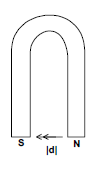
TORQUE ON A BAR MAGNET
Due to equal and opposite forces acting on the poles of a bar magnet placed in a magnetic field B, a torque acts on it about an axis passing through the centre and perpendicular to the length:
τ = MB sinθ
where θ is the angle between magnetic field B and magnetic moment M.
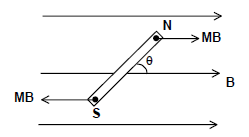
Diagram: Bar magnet in uniform magnetic field showing forces and torque
Time Period of Oscillations
Since the net force on the magnet is zero, the torque causes oscillations about equilibrium position θ = 0. For small angular displacement:
T = 2π√(I/MB)
Where I = mℓ²/12 for a thin magnet.
Note: Oscillations are simple harmonic only for small angular displacements and just periodic for large angular displacements.
Effect of Splitting Magnet
- Split into n parts parallel to length: M = M/n, I = I/n, T = T
- Cut into n parts perpendicular to length: M = M/n, I = I/n³, T = T/n
Comparing Magnetic Moments
For two magnets with time periods T₁ (like poles together) and T₂ (unlike poles together):
M₁/M₂ = (T₁² - T₂²)/(T₁² + T₂²) = (n₂² - n₁²)/(n₂² + n₁²)
MAGNETIC INDUCTION DUE TO A BAR MAGNET
- On the Axial Line
B = (μ₀/4π) × (2Md)/(d² - ℓ²)²
When ℓ << d:
B = (μ₀/4π) × (2M/d³)
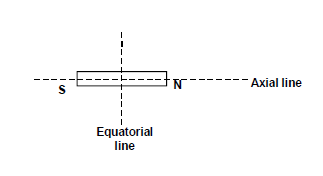
- On the Equatorial Line
B = (μ₀/4π) × (M)/((d² + ℓ²/4)^(3/2))
When ℓ << d:
B = (μ₀/4π) × (M/d³)
Diagram: Bar magnet showing axial and equatorial lines
- At Any Point
Magnetic induction due to short bar magnet at distance d from centre making angle θ with S-N axis:
B = (μ₀/4π) × (M/d³) × √(1 + 3cos²θ)
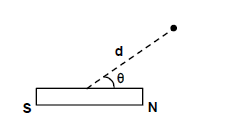
- Magnetic Potential
Work done in bringing a unit north pole from infinity to a point in magnetic field:
V = (μ₀/4π) × (M cosθ/d²)
Note: Magnetic potential at any point on equatorial line of bar magnet is zero.
WORK DONE IN ROTATING A BAR MAGNET
Work done in rotating a bar magnet against the torque:

- Potential Energy
U = -M⃗·B⃗ = -MB cosθ
As work done equals change in potential energy: W = U₂ - U₁ = MB(cosθ₁ - cosθ₂)
TERRESTRIAL MAGNETISM
Earth can be considered as a bar magnet with south pole towards geographic north and north pole towards geographic south.
- Meridian: Plane passing through point and corresponding poles (magnetic or geographic)
- Declination: Angle between magnetic meridian and geographic meridian (max 17° at equator)
- Dip/Inclination: Angle made by Earth's magnetic field with horizontal (0° at magnetic equator, 90° at magnetic pole)
Components of Earth's Magnetic Field
BH = B cosδ (Horizontal component)
BV = B sinδ (Vertical component)
Where δ is the dip angle.
B = √(BH² + BV²)
tanδ = BV/BH
Apparent Dip
If plane is at angle θ with magnetic meridian, apparent dip δ₁ is:
tanδ₁ = tanδ/cosθ
For two mutually perpendicular directions:
cot²δ = cot²δ₁ + cot²δ₂
BAR MAGNET IN EARTH'S MAGNETIC FIELD
When bar magnet is kept in Earth's magnetic field, resultant field is vector sum of both fields. A null or neutral point is where resultant magnetic field parallel to Earth's surface is zero.
- North pole towards geographic north: Null points on equatorial line
- North pole towards geographic south: Null points on axial line
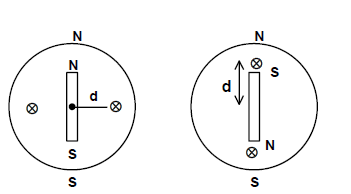
Diagram: Bar magnet in Earth's field showing null points
Deflection of Magnetic Needle
When magnetic needle is in two perpendicular magnetic fields BH and B:
tanθ = B/BH
where θ is deflection angle.
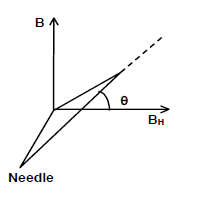
TANGENT GALVANOMETER
A coil of n turns carrying current i produces magnetic field along axis:
B = (μ₀ni)/(2r) where r is radius of coil.
If field is horizontal and perpendicular to BH:
tanθ = B/BH
i = (2rBH)/(μ₀n) × tanθ = k tanθ
k is called reduction factor of galvanometer.
PROPERTIES OF MAGNETIC MATERIALS
- Magnetizing Force (H): Force that induces magnetism in material
- Intensity of Magnetization (I): Magnetic moment per unit volume or pole strength per unit area
I = M/V = m/A
- Relations
B = μH = μ₀μᵣH = μ₀(H + I)
- Magnetic susceptibility:
χ = I/H
μᵣ = 1 + χ
- Hysteresis Loop
Plot of intensity of magnetization against magnetizing field.
- Retentivity: Residual magnetism when external field is zero
- Coercivity: Capacity to retain magnetism despite demagnetizing process
- Area of loop: Represents work done or energy loss
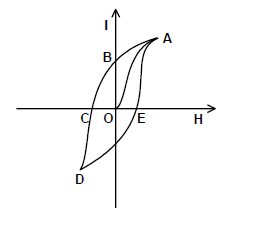
Diagram: Hysteresis loop showing retentivity and coercivity
PARA, DIA AND FERROMAGNETIC MATERIALS
Diamagnetic materials are repelled by magnets. Relative permeability is positive and less than one. Magnetic susceptibility is negative and small. Diamagnetic property is shown by materials with paired electrons and is independent of temperature. Ex: Bismuth, Zinc, Copper, Silver, water, nitrogen and hydrogen.
Paramagnetic materials are feebly attracted by magnets. They get magnetized along the direction of the magnetic field. Relative permeability is more than one and positive. Magnetic susceptibility is small and positive.
![]()
which is known as curie's law and C is curie's constant. Materials with unpaired electrons in their valence orbits exhibit this property.
- Example: Aluminium, Sodium, Platinum, Manganese and oxygen,
Ferromagnetic materials are strongly attracted by magnets. Relative permeability is very large and magnetic susceptibility is very high and positive. Magnetic susceptibility is constant upto a certain temperature above which it varies with temperature according to the equation.
![]()
Where K and TC are constants and TC is called Curie temperature above which a ferromagnetic material becomes paramagnetic.
Ferromagnetism is due to the existence of magnetic domains.
Example: Iron, Nickel, Cobalt and Gadolinium.
MAGNETIC FIELD DUE TO CURRENT
Magnetic field due to current can be calculated using:
- Biot-Savart's Law (general cases)
- Ampere's Circuital Law (symmetrical cases)
Biot-Savart's Law
To get the magnetic field at a point using Biot-Savart's law, we need to understand the term current-element. Current element is the product of current and length of infinitesimal segment of current carrying wire. The current element is taken as a vector quantity. Its direction is same as the direction of current.
dB⃗ = (μ₀/4π) × (Idl⃗ × r⃗)/r³
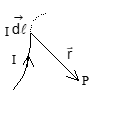
For entire wire segment:
B⃗ = (μ₀I/4π) ∫ (dl⃗ × r⃗)/r³
Here mo is proportionality constant, called permeability. In SI units the value of mo/4p is equal to 10-7 Tesla-meter/ampere. The SI units of magnetic fields are Tesla, weber/m2.
In the above expression limits of the integral depend on the shape and size of the current carrying wire.
Magnetic Field Due to Different Current Systems
1. Straight Wire
B = (μ₀I/4πR)(sinα - sinβ)
For infinitely long wire (α = π/2, β = -π/2):
B = μ₀I/(2πR)
2. Arc of Circle
B = (μ₀I/4πR) × θ
For complete circle (θ = 2π):
B = μ₀I/(2R)
3. On Axis of Circular Loop
B = (μ₀IR²)/(2(R² + x²)^(3/2))
4. Solenoid
At centre:
Bcentre = (μ₀nI/2)(sinα - sinβ)
For long solenoid (α = 90°, β = -90°):
Bcentre = μ₀nI
At ends:
Bends = μ₀nI/2
Illustration: A charge q moves in circular path of radius r with speed v. Calculate magnetic field at centre.
Solution:
Equivalent current: I = qv/(2πr)
Magnetic field: B = μ₀I/(2r) = μ₀qv/(4πr²)
Magnetic Moment
Magnetic field at any point on the axis of the loop is along the axis only. We have already calculated the direction of magnetic field using BIOT-SAVART Law. We can also calculate the direction of magnetic field directly using right-handed nut-bolt system. "Take a nut fitted with a bolt and hold it in such a way that plane of the nut should be parallel to the plane of the loop. Now rotate the bolt in same sense as the sense of current in the loop. The bolt will move in the direction of magnetic field."
A closed loop behaves like a magnetic dipole, its magnetic moment is given by the expression M = NIA Here N = no of turns
A= area vector and its direction can be given by right handed nut-bolt system.
Gauss's Law of Magnetism
∮ B⃗·ds⃗ = 0
Net flux of B through any closed surface is zero.
Ampere's Law: ∮ B⃗·dl⃗ = μ₀I
Line integral of B around closed path equals μ₀ times total current through surface bounded by path.
MOTION OF A CHARGED PARTICLE IN A MAGNETIC FIELD
In previous chapter we studied about the source of magnetic field. In this chapter we shall study the effect of magnetic field on a moving charge and on current carrying wire.
In magnetic field force experienced by a charged particle is given by the expression:
Fm = q(v × B)
Here,
- v = velocity of the particle
- B = magnetic field
On the basis of above expression, we can draw the following conclusions:
- Stationary charge (i.e. v = 0) experiences no magnetic force.
- If v is parallel or anti parallel to B then the charge particle experiences no magnetic force.
- Magnetic force is always perpendicular to both the v and B.
- As magnetic force is always perpendicular to the velocity (→v), the magnetic force does not deliver power to the charged particle.
- As magnetic force is always perpendicular to →v, this force will compel the charge particle to move on a circular path.
-
On the basis of Expression for Magnetic Force →F = q(→v × →B) The maximum value of the magnetic force is F = qvB which occurs when the charge is projected perpendicular to the magnetic field. This makes the path of the charged particle purely circular (in uniform →B), and magnetic force provides the necessary centripetal force.
- Radius of the Circular Path
If radius of the circular path is R:
mv2 R = qvB , where m = mass of the particle.
Therefore, R = mvqB
- Time to Complete One Revolution
T = 2πRv = 2πmqB
- Helical Path of a Charged Particle
If the charged particle is projected neither parallel nor perpendicular to the field, its velocity →v can be resolved into two components: one along →B (v_{||}) and the other perpendicular to →B (v_{\perp}).
Experiences a magnetic force and tends to move on a circular path due to v⊥.
Experiences no force and tends to move straight along the field due to v∥.
Illustration: A uniform magnetic field of 30 mT exists in the +X direction. A particle of charge +e and mass 1.67 × 10-27 kg is projected through the field in the +Y direction with a speed of 4.8 × 106 m/s.
- (a) Find the force on the charged particle in magnitude and direction.
- (b) Find the force if the particle were negatively charged.
- (c) Describe the nature of path followed by the particle in both the cases.
Solution:
(a)F = qvB sin θ
Calculation:
F = (1.6 × 10-19) × (4.8 × 106) × (30 × 10-3) × sin 90o =2.304 × 10-15 N
The direction of the force is in the (-z) direction.
(b) If the particle were negatively charged, the magnitude of the force would be the same, but the direction would be along the (+z) direction.
(c) As v ⊥ B, the path described is a circle.
R = mv qB
Substituting values: R = (1.67 × 10-27) × (4.8 × 106) (1.6 × 10-19) × (30 × 10-3) = 1.67 m
Lorentz Magnetic Force
dF⃗ = I(dl⃗ × B⃗)
Net force on wire:
F⃗ = I ∫ (dl⃗ × B⃗)
Note: No net force on current carrying loop in uniform magnetic field.
Fleming's Left Hand Rule
Index finger → Magnetic field direction
Middle finger → Current direction
Thumb → Force direction
Force Between Parallel Conductors
Magnetic field at distance r from wire carrying current I₁:
B = μ₀I₁/(2πr)
Force per unit length on second wire:
F/l = μ₀I₁I₂/(2πr)
Note: Wires carrying current in same direction attract each other.
Torque on Current Loop
Current carrying loop in uniform magnetic field experiences torque:
τ⃗ = M⃗ × B⃗
where M⃗ = IA⃗ is magnetic moment of loop.
MOVING COIL GALVANOMETER
Coil of N turns, area A carrying current I in magnetic field B experiences torque:
τ = NIAB sinθ
For radial field (θ = 90°):
τ = NIAB
Balanced by restoring couple:
NIAB = Cφ
I = (C/NAB)φ = kφ
where k is galvanometer constant.
Current Sensitivity
S = φ/I = NAB/C
AMMETER
Galvanometer with small parallel resistance (shunt) for measuring current.
Shunt Resistance
To increase range from ig to i:
S = G/(n-1) = Gig/(i-ig)
where n = i/ig is multiplication factor.
Fractional Error
If ammeter has resistance r in circuit with external resistance R:
Fractional error = r/(R+r)
Ideal Ammeter: Should have zero resistance
VOLTMETER
Galvanometer with high series resistance for measuring potential difference.
Series Resistance
To convert galvanometer (resistance G, max current Ig) to voltmeter of range V:
R = V/Ig - G
Fractional Error
If voltmeter has resistance r measuring voltage across resistance R:
Fractional error = R/(R+r)
Ideal Voltmeter: Should have infinite resistance
EXERCISES
Exercise 1:
-
Solenoid of infinite length, 0.1 A per turn, 2000 turns. Find magnetic field inside. Answer: 8×10⁻⁵ T
-
Semi-circular loop on X-Z plane, semi-infinite parts on X-Y plane. Find B at origin. Answer: μ₀I/(4A)
-
Circular loop, radius 12cm, B = 0.5×10⁻⁴ T at centre. Find B at 5cm on axis. Answer: 3.9×10⁻⁵ T
-
Is magnetic field of current loop uniform? Answer: No
Exercise 2:
- Electron with velocity âk in magnetic field b î + ĉ ĵ. Find magnetic force. Answer: ea(bĵ - cî)
- Can charged particle from field-free region complete closed path in magnetic field? Answer: No
- Smallest B at equator for proton (speed 10⁷ m/s) to circulate around Earth? Answer: 1.6×10⁻⁸ T
FORMULAE AND CONCEPTS AT A GLANCE
Key Formulae:
1. Magnetic dipole moment: M⃗ = md⃗ = IA⃗
2. Magnetic field: B = (μ₀/4π) × (m/d²)
3. Magnetic field due to current: B = (μ₀I/4π) × (dl⃗ × r⃗)/r²
4. Tangent law: tan θ = H/BH
5. Permeability: μᵣ = 1 + χm
6. Force on conductor: F⃗ = I(dl⃗ × B⃗)
7. Force between parallel conductors: F = (μ₀I₁I₂l)/(2πr)
8. Lorentz force: F⃗m = q(v⃗ × B⃗)
© FIITJEE Group - Complete Study Material on Magnetism and Magnetic Effects of Current
Frequently Asked Questions
Magnetism arises due to the motion of electric charges at the atomic level. Inside every atom, electrons spin around their nucleus and also move in orbitals. Both these movements create tiny magnetic fields. When billions of atoms in a material align their magnetic moments in the same direction, the overall effect is strong enough to be observed as magnetism. This is why materials like iron, cobalt, and nickel become magnets their atomic magnetic fields align collectively.
At a deeper level, magnetism is linked to the electromagnetic force, one of the four fundamental forces of nature. The same force governs both electric charges and magnetic interactions. A key principle here is that moving charges create magnetic fields. This means whenever electricity flows through a wire, it generates a magnetic field around it.
To visualize magnetism, think of magnetic field lines. These are invisible loops around magnets or current-carrying wires, showing the direction and strength of the force. Compasses, for example, align along Earth’s magnetic field lines, helping navigation.
Understanding magnetism is critical not just in physics theory but also in real-life applications: electric motors, transformers, maglev trains, and even MRI machines rely on the principles of magnetism. For students, the takeaway is simple: magnetism is electricity in motion, and the patterns it forms are consistent and predictable. Grasping this core idea makes learning advanced electromagnetic concepts much easier.
Magnetic fields form whenever electric charges move. At the most basic level, every electron in an atom acts like a tiny loop of electric current because of its spin and orbital motion. These loops create micro-magnetic fields. When most of these align in the same direction in a substance, we get a strong, observable field.
The simplest way to see this is by passing current through a wire. Place a compass near the wire as soon as current flows, the compass needle deflects. This shows that a magnetic field has been created around the wire. The field’s direction follows the right-hand rule: if you curl your right hand’s fingers around the wire in the direction of the current, your thumb points in the direction of the magnetic field.
In permanent magnets, the field is caused by the alignment of atomic magnetic moments. In electromagnets, the field is produced by electric current flowing through coils of wire. This means magnetic fields can either be naturally occurring (like Earth’s magnetic field) or artificially generated.
Magnetic fields are vital in science and technology: they enable data storage in hard drives, help in medical imaging, and are used in particle accelerators to bend charged particles. For exam preparation, remember the golden rule: electric current generates magnetic fields, and moving magnetic fields can create electric current (Faraday’s law of induction).
Yes, in modern physics, magnetism can be explained as a relativistic effect of electricity. According to Einstein’s theory of special relativity, when an observer moves relative to an electric charge, they may perceive both an electric field and a magnetic field instead of just one.
For example, consider a wire with moving charges (current). In the wire’s frame, electrons are moving, and the net effect is seen as a magnetic field around the wire. But in the electrons’ frame, the protons in the wire appear to be moving, creating an electric field. Relativity connects the two perspectives: magnetism is essentially electricity observed from a moving frame.
This viewpoint helps unify electricity and magnetism into a single concept: electromagnetism. They are not separate forces but two sides of the same coin. This understanding also explains why electric and magnetic fields can transform into each other under different conditions.
For students, the practical value is in realizing that electricity and magnetism are deeply linked, and understanding one helps in mastering the other. For exams, focus on how current produces magnetic fields, but keep in mind the deeper principle: magnetism is electricity seen through the lens of relativity.
The key to mastering “Magnetic Effects of Electric Current” is structured preparation. Start with your NCERT or standard physics textbook because it covers all the basics in a logical sequence. Focus first on understanding concepts before moving to problem-solving. Break the topic into smaller parts: (1) Oersted’s experiment showing current produces a magnetic field, (2) Right-hand rule and field around a straight wire, (3) Field due to solenoid and coil, and (4) Force on a current-carrying conductor.
Once concepts are clear, move to worked examples. Pay special attention to diagram-based questions because they are frequently asked in exams. Practicing numerical problems involving formulas such as F = BIL (force on a current-carrying wire) and Biot-Savart law will give you confidence.
To revise effectively, use concise notes or flashcards. Summarize every sub-topic in a few lines. For example, “Magnetic field around solenoid = uniform, resembles bar magnet.” Revise these daily. Past year CBSE/ICSE/NEET/JEE questions are essential because they reveal the recurring patterns.
Lastly, use visual aids. Watching animation-based videos or interactive simulations can make abstract field lines and forces more tangible. Stick to a schedule: 30 minutes for theory, 30 minutes for numericals, 15 minutes for quick recall. With consistent practice, you’ll retain the concepts much longer.
Electromagnetism is the combined study of electric and magnetic phenomena. A common theory question is: How does current create a magnetic field?
The answer begins with Oersted’s experiment, proving that a wire carrying current deflects a compass needle. From here, we build on Maxwell’s equations, which show that electric and magnetic fields are interdependent.
Another frequent question is about applications of electromagnetism: electric motors, generators, transformers, and electromagnetic waves. When preparing, focus on concept clarity. Theory questions require both definition and explanation with diagrams. For example, when asked about solenoids, include diagrams showing uniform magnetic field lines.
For exams, write structured answers: Definition → Explanation → Diagram → Application. This ensures clarity and scoring. For NEET or JEE, add formula derivations where relevant. Reading concise theory notes, followed by solving descriptive past papers, is the most efficient way to master theory-based questions.
A current generates a magnetic field because moving electric charges create a force in the surrounding space. This was first discovered by Hans Christian Ørsted in 1820 when he noticed that a compass needle deflected whenever a wire carried current near it. The explanation lies in the fundamental laws of electromagnetism.
Electrons in motion constitute an electric current. According to Maxwell’s equations, whenever charges move, they produce a magnetic field perpendicular to the direction of current flow. The strength of this field depends on the amount of current and the distance from the wire. The right-hand rule is used to determine direction: if you wrap your right hand around the wire with the thumb pointing in the current’s direction, your curled fingers show the magnetic field’s orientation.
In practical terms, this principle is applied everywhere. The coils in motors use current to create strong magnetic fields, converting electrical energy into mechanical motion. In transformers, alternating currents generate changing magnetic fields, allowing efficient energy transfer between circuits. Even Earth’s magnetic field originates from electric currents flowing in its molten iron core.
For exams, students should remember: (1) Oersted’s experiment, (2) the Biot–Savart law, and (3) the formula for magnetic field around a long straight conductor, B = (μ₀I) / (2πr). The step-by-step reasoning is critical: moving charges → magnetic field → observable effects.
Understanding this cause-effect relationship not only prepares you for school-level exams but also builds the foundation for advanced physics and engineering topics. Always combine conceptual diagrams with numerical practice to solidify learning.
A changing magnetic field induces electricity due to Faraday’s Law of Electromagnetic Induction. Michael Faraday’s experiments in 1831 showed that when the magnetic flux through a coil changes, it produces an electromotive force (EMF) in the coil. This means that electricity can be generated without direct contact, just by varying the magnetic environment.
The concept can be explained as follows: Magnetic flux (Φ) is the product of the magnetic field strength (B) and the area (A) it passes through, with orientation considered. Faraday’s law states:
EMF = – dΦ/dt
This means the induced voltage is proportional to how quickly the flux changes. The negative sign represents Lenz’s Law, which states that the induced current always opposes the change causing it.
Practical applications are immense. Electric generators work entirely on this principle: rotating coils within magnetic fields produce electricity. Induction cooktops heat vessels by changing magnetic fields. Even your phone’s wireless charger uses electromagnetic induction to transfer power.
For students, it is important to understand both qualitative and quantitative explanations. Qualitative: “Changing magnetic field → changing flux → induced EMF.” Quantitative: Apply Faraday’s formula and solve numericals based on coil turns, field strength, and time variation.
This principle bridges the gap between magnetism and electricity, proving they are not separate but interlinked phenomena. Mastering it not only helps in exams but also provides insight into how much of modern technology functions.
The magnetic field around a current-carrying wire exists because moving charges produce a force on other charges in their vicinity. Imagine free electrons moving in a wire. Each moving electron generates a tiny magnetic field, and collectively, these add up to form a measurable field around the wire.
This can be observed using the compass test: place a compass near a wire with current, and the needle deflects immediately. The magnitude of the field decreases as you move away from the wire, showing it weakens with distance. The direction is determined by the right-hand thumb rule.
The formula governing this is B = (μ₀I) / (2πr), where I is current, r is distance from wire, and μ₀ is permeability constant. This clearly shows the two factors controlling the field: stronger current increases field strength, and greater distance weakens it.
Applications are everywhere: power lines produce magnetic fields, solenoids use this principle to generate uniform fields, and magnetic resonance imaging (MRI) machines use current-driven electromagnets for diagnostics.
For effective exam answers, always combine formula, diagram, and example. Explain the concept, draw concentric field lines around the wire, and conclude with practical relevance. This balanced approach ensures high marks and deeper conceptual understanding.
Electricity and magnetism are related but distinct aspects of the electromagnetic force. Electricity involves the presence and motion of electric charges, while magnetism arises due to the motion of these charges.
Electricity can exist in two forms: static electricity (charges at rest) and current electricity (charges in motion). Magnetism, however, is inherently tied to motion: even the permanent magnet effect comes from the spin and orbital motion of electrons inside atoms.
The differences can be summarized:
- Electricity is caused by stationary or moving charges, magnetism is caused only by moving charges.
- Electric fields radiate outward from charges, magnetic fields always form closed loops.
- Electricity can exist independently (static charges), but magnetism always accompanies motion of charges.
Despite these differences, electricity and magnetism are unified under electromagnetism. For instance, a changing electric field can generate a magnetic field, and a changing magnetic field can produce an electric current. This interdependence forms the basis of Maxwell’s equations.
Applications highlight their unity: electric motors, generators, transformers, and electromagnetic waves (radio, light, X-rays). Understanding both helps students grasp how modern technology works, from household appliances to advanced medical and communication devices.
Moving magnetic fields produce electricity through electromagnetic induction. When a magnet is moved relative to a coil of wire, the magnetic flux through the coil changes. According to Faraday’s Law, this change induces a current in the wire.
The practical impact of this principle is enormous. Every generator — whether in a hydroelectric dam, wind turbine, or thermal power station — works by moving magnetic fields relative to conductors. The faster the field changes, the greater the induced current.
Lenz’s Law ensures the induced current opposes the cause of its generation. For example, if you push a magnet into a coil, the induced current generates its own field resisting the magnet’s motion. This principle is key in understanding real-world systems like regenerative braking in trains, where magnetic resistance slows down vehicles while producing electricity.
Students should connect this concept to exam-ready examples:
- “Moving magnet near coil → induced current”
- “Rotating coil in magnetic field → generator working principle”
This question directly links electricity and magnetism, making it vital for both conceptual clarity and application-based problem-solving.
In certain cases, yes but in most practical scenarios, electricity and magnetism are inseparable. Static electricity (like charges building up on a balloon after rubbing) does not involve magnetism because charges are stationary. However, the moment charges begin to move (as in a current), magnetism appears.
At a fundamental level, electricity and magnetism are two sides of electromagnetism. Maxwell’s equations show that a changing electric field produces a magnetic field, and vice versa. This means while charges can exist at rest without producing magnetism, in dynamic systems electricity cannot be separated from magnetism.
Practical understanding:
- Electric field only: A charged balloon sticking to a wall.
- Magnetic field with current: Current through a wire deflecting a compass needle.
- Unified case: Electromagnetic waves (like light) where oscillating electric and magnetic fields sustain each other.
The takeaway: electricity without magnetism is only possible in static conditions, but in almost every technological application — motors, circuits, communication systems — the two phenomena are deeply linked. For exam answers, students should highlight both the exception (static case) and the general rule (electricity in motion always has magnetism).